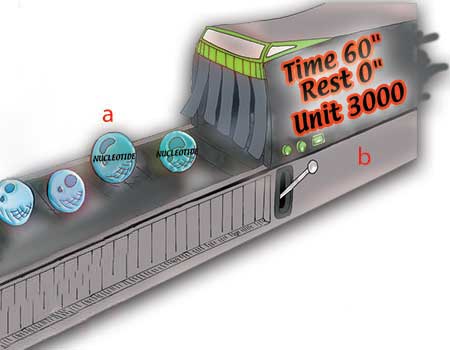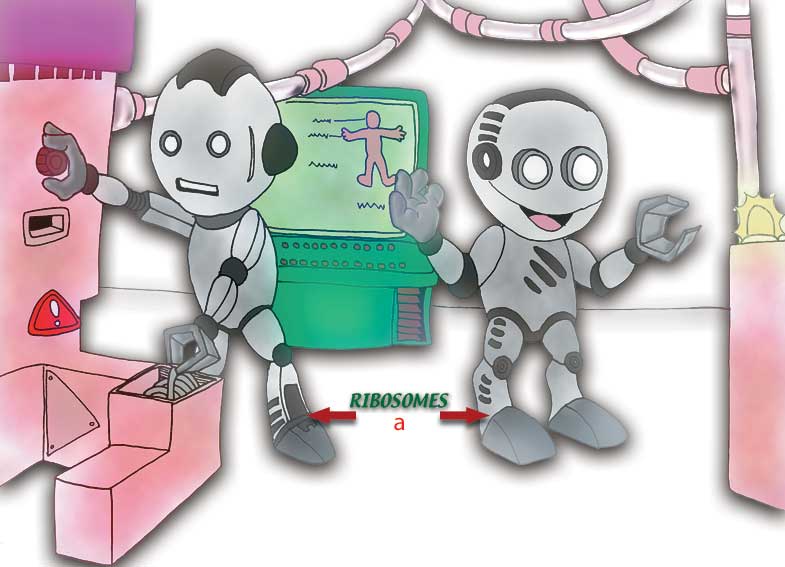As you know, cells replicate themselves by dividing. But what happens to DNA as a result of this division process? There is one single DNA strand in each cell. Yet the newly emerging “twin” cell will also need complete DNA of its own. In order to achieve this, a series of processes takes place, every stage of which is an independent miracle. As a result, an exact copy of the “original” DNA is formed shortly before cell division takes place, and this copy is transferred to the new-formed cell.
In order to replicate itself, DNA first separates itself into two opposite parts. This takes place in a most interesting manner. The DNA molecule, which resembles a spiral staircase, split down the middle, much like a zipper being unzipped, by an enzyme called DNA helicase. As the arms of the DNA separate from one another, helix-stabilizing enzymes keep both arms fixed, in order that they should not wrap round one another again (Figure 101).
The DNA has now been divided into two halves. The missing halves of each are completed with materials available around them. The task of making good these gaps is performed by DNA polymerase. Thus, two new DNA molecules are produced (Figure 102).
 |
| a. DNA Polymerase |
| Figure 101: As the DNA's two arms separate from one another, helix-stabilization enzymes (HSE) hold both arms fixed to prevent them rewinding around each other. Side: The arms of a DNA molecule separating from one another. Figure 102: After the DNA has been divided into two parts, polymerase enzymes complete the missing halves of both arms, using the materials readily available around them. |
The new DNA molecules that emerge during this matching are checked many times by supervisory enzymes. If any error has taken place (and any such error could have fatal consequences), it is immediately identified and corrected. Incorrect DNA codes are torn apart, replaced with correct ones, and then re-assembled. All these processes take place at such a dizzying speed that a 3,000-step nucleotide is produced in a minute, during which time all these steps are checked and the necessary adjustments made many times (Figure 103).
 | |
| a. nucleotides | Time: 60 sec |
| Figure 103: DNA replication processes are carried out at great speed. Every minute, 3,000-step nucleotides are produced and all these steps are controlled by the enzymes responsible. | |
As a result of external factors such as radiation or pollution, more errors than normal may occur in the newly produced DNA molecule. This time, the ribosomes in the cell begin to produce DNA-repairing enzymes in light of the commands coming from the DNA. Thus the DNA is protected, and the survival of the daughter cells—and the entire organism—is ensured (Figure 104).
Unknown to you, countless processes and supervision are performed, and precautionary measures are taken, over the course of the day, to allow you to continue with your life in a problem-free manner, with an astonishing care and sense of responsibility. Each task is performed flawlessly and successfully. Almighty God has placed countless atoms and molecules, from the smallest (hydrogen atoms) to the largest (polymer molecules), at our service, in order for us to live agreeable, healthy lives.
 |
| a. Ribosomes |
| Figure 104: Just like robots, ribosomes in the cell begin producing DNA-repair enzymes according to instructions from the DNA. |
One of the most amazing aspects of these enzymes, which ensure the production of DNA and also monitor its structure, are proteins produced in the light of information recorded in the DNA itself, and under the command and control of that same DNA. This system is so magnificent and interconnected that it’s impossible for it to have come into existence by chance. DNA must exist in order for the cell to be, but the cell must exist in order for DNA to be—and the cell has to exist in order for both to be.! Moreover, the cell has to be fully formed, from its membrane down to all its tiny, complex organelles.
The theory of evolution, which claims that living things developed in stages as a result of consecutive beneficial coincidences, has no answer to the question of whether DNA or the necessary enzymes described above came into existence first. For a cell to survive, let alone reproduce, both the DNA and enzymes need to exist at one and the same time. And that is impossible in terms of the imaginary mechanisms proposed by the theory of evolution.